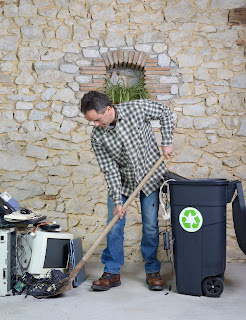How to get rid of your computer

#1 Save essential files
Back up your data or transfer files to a new computer. The easiest way to do this is to invest in an external hard drive. If you're looking for secure ongoing backup and file syncing solution, use a cloud service such as Box, Apple iCloud, Google Drive or Microsoft’s OneDrive of for more assistance call 10D Tech 541.243.4103
Backing up data to the cloud will quickly transfer it back to a new machine or enable access to it via an Internet connection, even from your Android or iPhone. Storing data in the cloud is also very convenient if your computer dies and you need to restore your files. You can also get to the data if you travel and need access to data or information on a different device.- Delete and overwrite sensitive files: Tax documents & other confidential data should be deleted with software specially designed to meet the government standards for secure data deletion. For hard drives in Windows PCs, try File Shredder (its free). For the older Macs with hard drives (pre-OS X El Capitan or OS 10.11) select the “Secure Empty Trash” option after deleting your files. You’ll see it under Finder > Secure Empty Trash. Macs with OS 10.11 and higher and Windows PCs with SSD drives, encrypt your drive. Encryption should be a standard practice at all times with all computers if it is available. Wiping your drive after these steps will securely erase your files.
- Turn on drive encryption. For Windows PCs with SSD drives, go to Settings > About. Toward the bottom, you'll see either an option for Drive Encryption or Bitlocker Settings. Follow the prompts to encrypt your drive. For Macs, go to System Preferences > Security & Privacy > FileVault and select Turn On FileVault. You'll then select a password and select Restart.
- Deauthorize your computer. Some programs, such as iTunes and Microsoft Office 365, only allow you to install software on a limited number of computers or allow a limited number of computers to access your files. So be sure to deauthorize your old equipment from your accounts - before uninstalling any programs.
- Delete your browsing history. Your internet browsers save info about your internet browsing history. How you have your settings configured, you may even store your usernames and site passwords at various websites. Obviously, you don’t want a stranger or, worse, a stranger with bad intentions having access to this information. For Microsoft Internet Explorer, you click on the cogwheel in the upper right corner, and it will open the browser menu, then click on the Safety option, and then Delete Browsing History. Make sure all of the checkboxes are chosen, so it all gets removed. Repeat this step for any other browsers on your computer (Firefox, Safari, Chrome). Firefox and Chrome, you will need to first sign out of your browser.
- Uninstall all of your programs. Many programs, such as Microsoft Office, will contain personal information like your name, address, and other details. We recommend uninstalling all programs before disposing of your computer. To uninstall programs on a PC: Start>Control Panel>Programs>click on program>click uninstall.
- Consult your employer or IT Dept about data disposal policies. If your computer is used for business, check with your company or IT Support company about how to manage the organization related information that is on your computer. Local, State and Federal laws require businesses to follow data security and disposal processes for deleting personal information about clients and customers.
- Wipe your hard drive. Once you've gone through and removed the information and data you know is there, perform a factory reset so you are confident that you have removed ALL of your personal files & software programs. Now restart your computer. Once the machine is back up, download & install the application “Eraser,” choose the most current version.
- OR physically damage your hard drive. If you are only looking to recycle your computer and are very anxious about somebody recovering your files, take out the hard drive and drill a couple of holes in it OR utilize the anger management training and beat the heck out of it with a hammer. This works for CDs, Jumpdrives cameras, etc, once the files you want are off them, a drill or hammer is a great way to say goodbye to your old media.




No comments:
Post a Comment